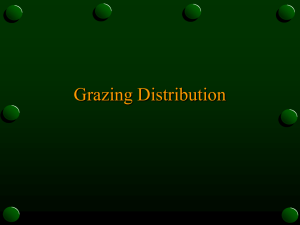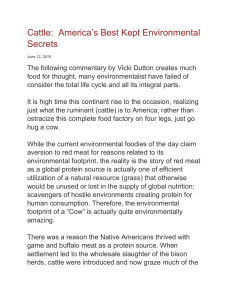Word - 37 KB - Department of the Environment
advertisement
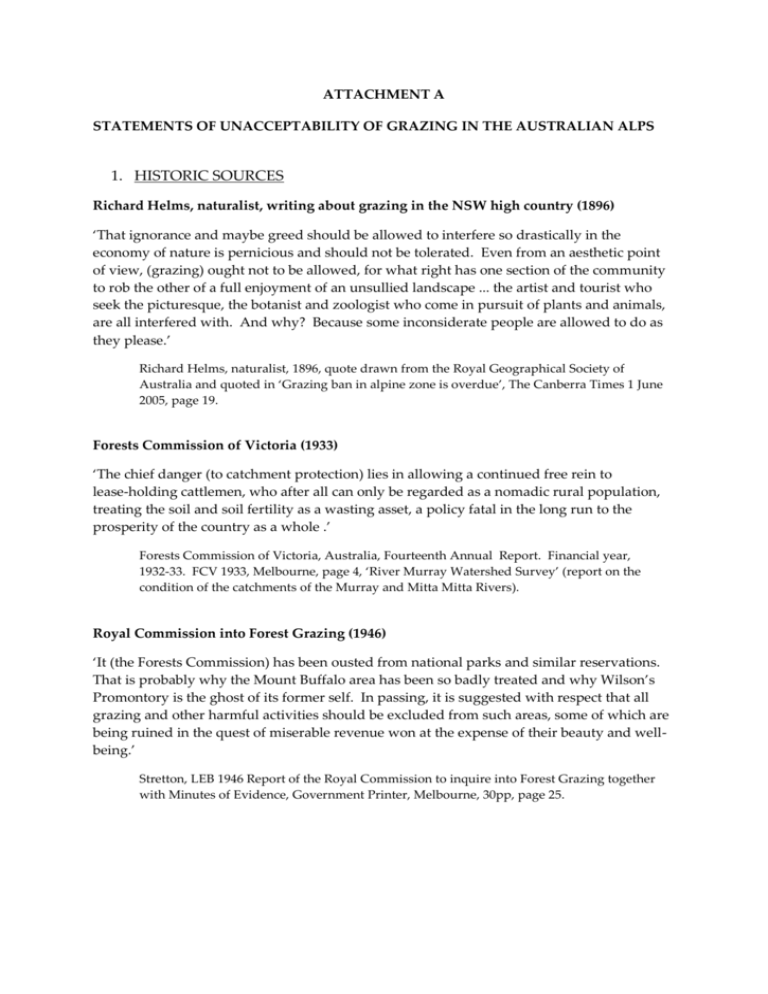
ATTACHMENT A STATEMENTS OF UNACCEPTABILITY OF GRAZING IN THE AUSTRALIAN ALPS 1. HISTORIC SOURCES Richard Helms, naturalist, writing about grazing in the NSW high country (1896) ‘That ignorance and maybe greed should be allowed to interfere so drastically in the economy of nature is pernicious and should not be tolerated. Even from an aesthetic point of view, (grazing) ought not to be allowed, for what right has one section of the community to rob the other of a full enjoyment of an unsullied landscape ... the artist and tourist who seek the picturesque, the botanist and zoologist who come in pursuit of plants and animals, are all interfered with. And why? Because some inconsiderate people are allowed to do as they please.’ Richard Helms, naturalist, 1896, quote drawn from the Royal Geographical Society of Australia and quoted in ‘Grazing ban in alpine zone is overdue’, The Canberra Times 1 June 2005, page 19. Forests Commission of Victoria (1933) ‘The chief danger (to catchment protection) lies in allowing a continued free rein to lease-holding cattlemen, who after all can only be regarded as a nomadic rural population, treating the soil and soil fertility as a wasting asset, a policy fatal in the long run to the prosperity of the country as a whole .’ Forests Commission of Victoria, Australia, Fourteenth Annual Report. Financial year, 1932-33. FCV 1933, Melbourne, page 4, ‘River Murray Watershed Survey’ (report on the condition of the catchments of the Murray and Mitta Mitta Rivers). Royal Commission into Forest Grazing (1946) ‘It (the Forests Commission) has been ousted from national parks and similar reservations. That is probably why the Mount Buffalo area has been so badly treated and why Wilson’s Promontory is the ghost of its former self. In passing, it is suggested with respect that all grazing and other harmful activities should be excluded from such areas, some of which are being ruined in the quest of miserable revenue won at the expense of their beauty and wellbeing.’ Stretton, LEB 1946 Report of the Royal Commission to inquire into Forest Grazing together with Minutes of Evidence, Government Printer, Melbourne, 30pp, page 25. 2. CESSATION OF GRAZING IN ALPINE NATIONAL PARKS Kosciuszko National Park The phase-out of grazing in high-altitude areas commenced after the 1944 declaration of Kosciusko State Park. Grazing ceased in 1958 in all areas above 4,500 feet (1370 metres) as a result of the 1957 recommendation by the Australian Academy of Science to do so. Grazing in other parts of the park was then phased out, with the last grazing occurring in 1972. Brindabella National Park This national park was declared in 1996. Grazing no longer occurs there but the date of cessation of grazing is not available. Namadgi National Park Grazing was phased out in most of the Cotter catchment area soon after it was designated as a domestic water supply for Canberra in 1914, with no grazing since 1917, well before the park was declared in 1984. The last grazing to occur in the park was in the Gudgenby valley in 1990. Baw Baw National Park Grazing ceased in the early 1980s as a result of a recommendation made by the Land Conservation Council (LCC) in 1977. Mount Buffalo National Park Grazing ceased in the early 1980s as a result of a recommendation made by the LCC in 1977. Snowy River National Park Grazing ceased in the Snowy River National Park following a recommendation made by the LCC in 1987. Avon Wilderness Park Grazing ceased in 1991 as a result of a recommendation made by the LCC in 1979. Alpine National Park Grazing was excluded from some of the highest peaks and ridges, including part of Mt Bogong in 1955 and Mt Feathertop in 1958, well before the park was declared, for environment protection purposes. In 1989 and 1991 grazing ceased at Wonnangatta Station, (and the Howitt Plains), due to its purchase by the Victorian Government, and in other parts of the park as a result of LCC recommendations made in 1979 and 1983. These areas were the northern Snowy Range, Snowy Plains, the Bluff, Wabonga Plateau, northern Bogong High Plains and remaining upper part of Mt Bogong. Grazing ceased east of the Snowy River in the Tingaringy National Park, now part of the Alpine National Park, in late 1988 following a recommendation made by the LCC in 1987. Cattle were also temporarily excluded from some areas to assist their recovery from the 1998 and 2003 fires. Remaining grazing licences expired in 2005 and were not renewed as a result of a decision by the Victorian Government following an inquiry conducted by the Alpine Grazing Taskforce. Grazing recommenced in some parts of the park in January 2011 as part of a fuel reduction trial. The cattle were withdrawn in early April 2011. The Victorian Government proposes to recommence the fuel reduction trial, including the grazing of 400 cattle, in December 2012. 3. SCIENTISTS Australian Academy of Science (1957) ‘That the aim to be achieved as soon as possible is the complete exclusion of all grazing animals from these important catchments at heights above 4,500 feet, and the effective policing of that exclusion.’ Australian Academy of Science 1957 A report on the condition of the high mountain catchments of New South Wales and Victoria, Canberra, 62pp, p. 28. Note: 4,500 feet equals about 1,370 metres. All alpine and most sub-alpine environments are above that height. Australian Academy of Science (2004) ‘The issues, in terms of ecology and economy, have not changed (since the Academy’s 1957 report) ... ‘ ‘Over five decades of research has shown that grazing and nature conservation in alpine areas are essentially incompatible land uses. The continuation of grazing within any of the Victorian alpine and sub-alpine national parks is at variance with established concepts and values of nature conservation.’ ‘Current and continued grazing by cattle in the alpine vegetation, especially where burnt, is incompatible with the maintenance of nature conservation values and ecosystem services.’ Australian Academy of Science 2004 Submission to the Alpine Grazing Taskforce, Victoria, June 2004, Canberra, pages 1, 4. Report to Parks Victoria on the adequacy of scientific research of grazing studies in the Victorian High Country by RH Groves, Senior Principal Research Scientist, CSIRO Plant Industry (1998) ‘There is no scientific reason why grazing by non-native animals should not have been excluded from the Victorian high country as early as 40 years ago. That grazing under licence has persisted in Victoria to the present is an indictment of Victorian land management authorities, including Parks Victoria and its predecessors, who have failed to take into account the scientific evidence available and give it its due in the politics of making decisions on land management.’ Groves R 1998 Grazing in the Victorian High Country – An Assessment of the scientific adequacy of grazing studies in the Victorian High Country 1945-1998, with some recommendations for future research – A Report to Parks Victoria, April 1998. Professor JB Kirkpatrick (1994) ‘The activity (stock grazing in the alpine and sub-alpine zones) is therefore completely incompatible with the maintenance of the natural alpine and subalpine biological diversity that supports World Heritage listing under criteria (ii) and (iv).’ (page 42) ‘There seems to be a strong case on the grounds of all four natural criteria for the listing of most of the MOU area under the World Heritage Convention. However, the area has a cultural legacy of disturbance of its natural integrity and some unacceptable (in terms of World Heritage) activities continue. The impression has been gained by many people involved in the World Heritage listing process that the Australian Alps have major natural integrity problems. Thus, to be successful, a nomination would need to emphasise the manner in which World Heritage listing would lead to the rectification of continuing threats to natural integrity, and result in the amelioration of manifestations of past disturbances. I suggest that the following commitments would be an appropriate minimum: 1. A rapid phase out of stock grazing in the area; ... ‘ (pages 64-65) Kirkpatrick, JB 1994 The International Significance of the Natural Values of the AustralianAlps, Australian Alps Liaison Committee, May 1994, pages 42, 64, 65. Professor Jared Diamond, international best-selling science author (2005) `There is so little alpine habitat in Australia that it is inexcusable to want to devote even one square inch of it to cattle grazing.’ Jared Diamond, quoted in ‘A look into grazing’, The Canberra Times 20 June 2005 page 4. Sir Gustav Nossal and Dr David Ashton (2005) ‘As scientists, we believe the recent decision to exclude cattle from the Alpine National Park is based on sound science ... The Victorian Alpine National park deserves the highest standards of protection – like Kosciuszko, which had cattle grazing stopped by the New South Wales government in 1972 ... when we hear scientists say that cattle and the Alpine National Park don’t go together, we can be confident that this is based on sound work undertaken over many years by generations of skilled and dedicated people. Stopping grazing is not the only important conservation measure ... ’ Sir Gustav Nossal (Australian of the Year 2000 and then chief scientist at the Department of Sustainability and Environment) and Dr David Ashton (eminent plant ecologist), ‘Cattle were killing our heritage’, Herald Sun 5 July 2005, page 20. Dr Alec Costin (2005) ‘Grazing in the Victorian Alps has always been the sticking point for World Heritage listing. The damage it causes to soils, alpine herbfields, mossbeds and water quality is not compatible with national park values.’ Dr Alec Costin, eminent alpine ecologist and former CSIRO botanist, ‘Heritage listing for Australian Alps sought’, The Canberra Times, 4 July 2005, page 4. The Carruthers Group of Alpine Ecologists and Scientists (2005) ‘The Carruthers Group of alpine ecologists and scientists has for many years given support to the removal of domestic stock grazing from the Australian Alps National Parks ... The Group applauds the Victorian Government for making the decision not to renew grazing leases in the Victorian Alpine National Park ... It (the end of grazing) will also provide an opportunity and stimulus to pursue appropriate national and international natural heritage recognition and listing for the Australian Alps Parks, which to date has not been possible while grazing continued within them.’ The Carruthers Group of Alpine Ecologists and Scientists 2005 ‘A Statement on the Proposal to Seek Cultural Heritage Listing for the Victorian Alpine National Park’ Dr Alec Costin, Prof Frank Fenner, Dane Wimbush, Roger Good, Prof Ralph Slatyer, Prof Jamie Kirkpatrick, Prof Geoff Hope, Dr Geoff Mosley, Graeme Worboys, Dr Jennie Whinam, Andy Spate, Dr Catherine Pickering, Dr John Harris, Prof Ralph Buckley. Letter signed by 125 scientists to the Victorian Minister for Environment and Climate Change (2011) ‘As concerned scientists, we write regarding the recently announced trial of strategic cattle grazing as a tool to reduce bushfire risk in Victoria’s high country, including the Alpine National Park. We strongly believe that the ban on livestock grazing in alpine parks should be maintained ... The Alpine National Park requires sensitive management to maintain its environmental and National Heritage values and the negative impact of cattle on Australian native ecosystems is well documented. The reintroduction of cattle into this area is not consistent with the objectives of managing National Heritage areas ... ‘ Letter dated 27 January 2011 to the Hon Ryan Smith MP, Minister for Environment and Climate Change, and signed by 125 scientists. 4. PUBLIC LAND-USE PLANNING AGENCIES AND GRAZING INVESTIGATIONS Land Conservation Council, Victoria (1979) ‘Council recognises the very high conservation values of the alpine and sub-alpine grasslands and herbfields and believes that the long-term aim should be to remove grazing from these areas.’ Land Conservation Council 1979 Final Recommendations – Alpine Area, page 73, Melbourne, June 1979. Land Conservation Council, Victoria (1983) ‘In some areas where grazing is a permitted use, a licence-holder may voluntarily decide not to renew his grazing licence. Where this occurs in areas of high conservation and recreation significance such as those high-altitude areas containing alpine and sub-alpine grasslands and herbfields, Council believes a new grazing licence should not be issued.’ Land Conservation Council, Victoria 1983 Final recommendations – Alpine Area Special Investigation, page 83, Melbourne November 1983 Land Conservation Council, Victoria (1991) ‘Council does not consider the grazing of domestic stock to be compatible with the land use objectives of wilderness areas. Council has resolved to recommend that grazing should be phased out of the wilderness areas within ten years.’ Land Conservation Council, Victoria, 1991 Wilderness Special Investigation Final Recommendations, November 1991, 196pp, p. 35. Note: Seven of the twenty wilderness areas recommended by the LCC are within the Alpine National Park and two within the Snowy River National Park. The then Victorian Government accepted these recommendations and these areas are now gazetted wilderness zones. Three of the proposed trial areas are directly adjacent to wilderness zones. Alpine Grazing Taskforce (2005) Selected findings: ‘1. Cattle damage water catchments, causing bare ground, soil disturbance and erosion, and trample mossbeds and watercourses. 2. At least at a localised level, grazing adversely affects water quality. 3. Grazing modifies and damages vegetation in the park, with the Taskforce finding the evidence of the damage caused by cattle to mossbeds and snowpatches to be compelling. 4. Cattle grazing is considered a significant threat to at least 25 flora species, 7 fauna species and 4 plant communities found in the park that are listed as rare, vulnerable or threatened with extinction. 5. Cattle have contributed to the establishment and spread of several weed species. 6. On the evidence before it, the Taskforce concurs with the conclusions of the 1998 Groves report, that the scientific research is adequate and consistently reveals that grazing has a deleterious effect on biodiversity. 7. Rehabilitation and restoration necessary to repair modified and damaged areas is very difficult with the continued presence of cattle. 8. The Taskforce finds significant damaging impacts and no overall benefits for the environment from cattle grazing in the Alpine National Park. 10. The Taskforce concludes that cattle grazing does not make an effective contribution to fuel reduction and wildfire behaviour in the Alpine National Park. 22. Cattle in the high country appeal to some visitors, but for many visitors their experience of the Alpine National Park is spoilt by the presence of cattle and their impacts. The experience is particularly negative for those expecting a pristine natural environment or seeking a wilderness experience. 23. The presence of free ranging cattle in areas used by family and other groups for camping and walking, and the sharing of drinking water sources, is a health and safety issue. 26. Despite grazing being specifically provided for in the National Parks Act, the Taskforce finds that cattle grazing in the Alpine National Park is inconsistent with the primary objects of the Act relating to national parks and wilderness areas. 27. Cattle grazing is not compatible with the national and international standards for a national park. 29. Grazing compromises the chances of the Australian Alps national parks being nominated for the World Heritage List based on their natural values. 30. Continuing grazing over all currently licensed areas (Option G1) offers both positive and negative economic and social outcomes, but would continue environmental impacts and degradation associated with grazing across some of the most significant and sensitive parts of Victoria. 31. Environmental outcomes and national park standards are clearly maximised if grazing were to cease across the park (Option G3). However, this would involve some economic and social costs, especially to current licensees.’ Alpine Grazing Taskforce 2005 Report of the investigation into the future of cattle grazing in the Alpine National Park, Department of Sustainability and Environment, Melbourne, May 2005, pp 5-7. 5. HERITAGE ORGANISATIONS Australian Heritage Council (2004) ‘The continued presence of grazing and associated impacts such as use of low-intensity fire, has a severe impact on the natural heritage of the Australian Alps. ‘ Australian Heritage Council 2004 Submission to the Alpine Grazing Taskforce, 31 May 2004 Australian Heritage Council (2005) ‘Cattle and feral horse grazing represents a major threat to natural heritage values (of the Alpine National Park). Alpine soils are particularly fragile and easily disturbed by hardhoofed animals, and injured ecosystems take many decades to regenerate in harsh alpine environments. The pre-European extent of alpine bog and fen is estimated at approximately 2000ha in Victoria. Since then at least half of these communities have been lost due to grazing impacts .......The Victorian Government recently chose to cease grazing in the Park and this will have a positive effect on natural heritage values. ‘ Australian Heritage Council 2005 Assessment Report for the Alpine National Park, 1 August 2005, 29pp, page 22. Australian Heritage Database, Canberra. Heritage Division, Department of the Environment and Heritage (2004) ‘The grazing of cattle in the Alpine National Park falls significantly short of constituting world’s best practice for national park and wilderness management and is considered to be a significantly inferior management regime compared to that in place in other reserves in the Australian Alps such as Namadgi and Kosciuszko National Parks.’ ‘Grazing in the Alpine National Park is highly inconsistent with the protection and proper management of the natural heritage values of the park and if continued into the future will result in the further deterioration of those values, particularly in relation to the alpine and sub-alpine areas of the park. As such, it is recommended that the Victorian Government does not continue the practice and that it implements a program to remediate the impacts of grazing activity on the alpine and sub-alpine environment.’ ‘The prospects of achieving a listing of the Australian Alps on either the National Heritage List or the World Heritage List, that relied partly or entirely on ecological and alpine and sub-alpine plant community values, would be very significantly enhanced if the necessary management actions were taken by the Victorian Government to ensure that cattle grazing no longer occurred within the Alpine National Park and that appropriate rehabilitation and restoration programs were implemented or being actively pursued.’ Department of the Environment and Heritage 2004 Submission by the Heritage Division of the Department of the Environment and Heritage to the Alpine Grazing Taskforce, Canberra, 18 June 2004 6. BROADER COMMUNITY Support for ban on cattle grazing in the Alpine National Park, advertisement in The Age (2005) ‘The Victorian Government has made the right decision to cease cattle grazing in Victoria’s Alpine National Park and to work with the ACT and NSW governments for World Heritage listing of the Australian Alps. The decision is backed by over 50 years of rigorous scientific study, which comprehensively proves the damaging effects of alpine grazing on soils, plants, animals and water catchments ...’ ‘This decision is long overdue, and the opportunity it presents must not be missed. It opens the door to pursuing appropriate national and international heritage recognition and listing for the Australian Alps – not possible while grazing continued in Victoria – and foreshadows Victoria’s first natural World Heritage site .... We urge the Commonwealth Government to support the move for World Heritage listing of the Australian alpine national parks. ‘Support for ban on cattle grazing in the Alpine National Park,’ advertisement in The Age 9 July 2005, page 12, signed by 48 individuals and organisations, including Ron Barassi AM, John Wood (actor), Rob Gell, Tim Macartney-Snape (mountaineer), Ian Kiernan AO (Chair, Clean-up Australia), Professor Sir Gustav Nossal, Dr John Stocker AO, Dr Malcolm Calder, (retired Professor of Botany, Melbourne University), Dr Jane Gilmour OAM (Exec Director, Earthwatch Institute). Victorian National Parks Association (1974) ‘We recommend ... that cattle grazing be phased out of the high country in the long term.’ Johnson, D 1974 The Alps at the Crossroads, VNPA, Melbourne, December 1974, 208 pp, page 19. Australian Conservation Foundation (1969) ‘The process of grazing withdrawal, already complete in some areas, should be continued until grazing has been removed throughout the high country.’ Australian Conservation 1969 The High Country, Viewpoint series No. 4, September 1969, Melbourne, 11 pp, page 11. (Introduction signed by Garfield Barwick, President of ACF). Victorian National Parks Association, Australian Conservation Foundation, WWF-Australia, National Trust, The Wilderness Society, Birds Australia, Bird Observation & Conservation Australia (BOCA), Friends of the Earth, National Parks Australia Council, Humane Society International, Invasive Species Council, Environment Victoria, National Parks Association of NSW (2011) ‘Sixty years of science shows cattle damage soils, trample moss beds and water courses, threaten rare native flora and fauna, spread weeds and reduce water quality in streams and rivers fed by alpine headwaters. Since grazing was removed in 2005 there has been a marked recovery of those areas ... We believe reintroduction of cattle grazing into the Alpine National Park will have a significant negative effect on the natural heritage values of the national park ... We call for an end to the grazing by domestic stock in the Alpine National Park ...’ Environment groups joint statement, 8 February 2011 Stop alpine grazing – it’s a park not a paddock! The Age Editorial (13 June 2005) ‘Allowing grazing in the Alpine National Park, however, is unsustainable on both environmental and economic grounds.’ The Age ‘A bull at the gate in support of alpine grazing’ Editorial, 13 June 2005, page 20. The Age Editorial (14 January 2011) ‘Regrettably, the new government’s first moves include some of its most regressive policies: restoration of cattle grazing in the Alpine National Park and the first full duck-hunting season in years. The Age has long objected to both practices because of the environmental harm ....’ ‘These delicate catchments, which feed the once-pristine headwaters of several major rivers through the seasons, and their unique flora and fauna have noticeably recovered since 2005 ... the issue of grazing should not have been revived once licences were cancelled and graziers compensated.’ The Age ‘State takes two steps back on conservation’ Editorial 14 January 2011, page 10. 7. GRAZIERS Sam Hemmings, grazier (2005) End the free ride ‘Mr Bracks – you have my support to pull the cattle out of the Alpine National Park. It’s for nature conservation, not primary production. I run my cattle on my own property, pay rates, improve the pastures, feed out hay in winter and check them daily for health problems or accidents. I’ve also got a horse and an oilskin coat but it doesn’t give me the right to claim virtually free agistment on public land. The heritage argument doesn’t wash. It’s time to make these few graziers pay the true cost of their animal husbandry – back on their own farms.’ Letter from Sam Hemmings, via Bairnsdale, to the Weekly Times 16 March 2005 page 14. Peter Walker (beef producer) (2005) Cattlemen’s free ride ends ‘The free ride of mountain cattlemen grazing national parks is over, and not before time. Cattlemen cite traditions and heritage in arguing their case, but fail to mention the real benefit; virtually free grazing for up to six months of the year. If the leases were based on realistic, commercial values of agistment, cattlemen would have left the parks years ago without generous taxpayer compensation.’ Letter from Peter Walker (beef producer), Sale, to the Herald Sun, 9 June 2005, page 19. Bill Bray, President, Cattle Council of Australia, former Victorian Farmers Federation pastoral group president (2005) ...told The Weekly Times that he supported the Government’s decision not to renew (alpine) grazing leases ...’I just look at other environmental practices across Victoria and the way other producers are managing their environment, and that’s where I believe the focus should be.’ Bill Bray, President, Cattle Council of Australia, former Victorian Farmers Federation pastoral group president, in ’Bray backs the ban’, The Weekly Times, 1 June 2005, page 5. Tom Guthrie, grazier (2005) ‘It would be fair to say there is a very solid section of the farming community who opposes (alpine) grazing ... it was a commonly held view that mountain cattlemen were getting exclusive right to cheap agistment that was not available to other farmers.’ Tom Guthrie, grazier, Mafeking, in ‘Bray backs the ban’, The Weekly Times, 1 June 2005, p 5. High country decision the right way to go `.... stand at one of the more degraded bogs in Pretty Valley on the Bogong High Plains and you don’t need to be a scientist to see what cattle can do to a sphagnum bog. Farmers all over the state have accepted their responsibility on environmental issues such as water quality, soil erosion and salinity and have embraced government schemes such as Landcare, Land for Wildlife, etc. They willingly fence off creeks, plant trees and rehabilitate the land. Unfortunately, the cattle on the high plains have been free to do the opposite as they trample alpine bogs and contaminate water streams.’ Letter from Tom Guthrie, grazier, to Stock and Land, 16 June 2005, page 8.

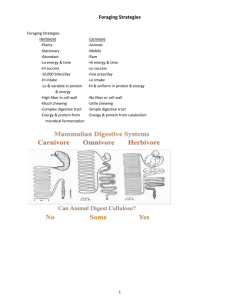

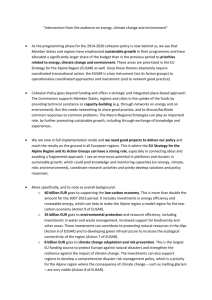
![Real-Life Climate Change Stories [WORD 512KB]](http://s3.studylib.net/store/data/006775264_1-25b312f26ec237da66580d55aa639ecf-300x300.png)

